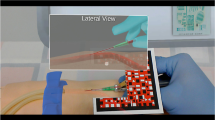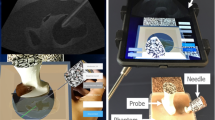Abstract
Purpose
Augmented reality (AR) technology improves the learning process in interventional radiology. This study hypothesized that using AR to train for central venous access is superior to using ultrasound alone.
Methods
This study used an AR central venous catheterization phantom with an internal jugular vein (IJV) and subclavian vein (SCV) made of resin body and soft tubing. Ten radiologists attempted to punctuate, using needle placement simulation, under three conditions (ultrasound-, augmented reality-, and ultrasound and AR-guided methods; US-only, AR-only, and US+AR, respectively) using a smart-glass device (HoloLens, Microsoft, Redmond, WA, USA). Subjective (anatomical understanding and self-confidence for procedure) and objective evaluations (optimized needle position and time) were recorded for each condition.
Results
The subjective IJV evaluation showed no difference among the guiding methods (p = 0.26 and p = 0.07 for anatomical understanding and self-confidence for procedure, respectively). Conversely, there were significant improvements in subjective and objective evaluations for SCV using the AR-only and US+AR methods (p < 0.05) and US+AR method (p < 0.05), respectively. The AR-only method reduced the time required to fix the needle position to puncture the SCV (p < 0.05), but its objective evaluation did not improve compared with the US-only method (p = 0.20).
Conclusion
Adding the AR-guided method to the US-guided method improved subjective and objective evaluations in the SVC procedure. The AR technology-assisted training may be more beneficial for use in difficult procedures. Though the AR-only method saved time, no time saving is expected with AR+US method.





Similar content being viewed by others
Availability of data and material
All data are included in the article.
Code availability
The in-house application used in this is not publicly available.
References
Frantz T, Jansen B, Duerinck J, Vandemeulebroucke JT (2018) Augmenting Microsoft’s HoloLens with vuforia tracking for neuronavigation. Health Technol Lett. https://doi.org/10.1049/htl.2018.5079
Rae RE, Lasso A, Holden MS, Morin E, Levy R, Fichtinger G, Webster RJ, Fei BE (2018) Neurosurgical burr hole placement using the Microsoft HoloLens. SPIE
Incekara F, Smits M, Dirven C, Vincent AF (2018) Clinical feasibility of a wearable mixed-reality device in neurosurgery. World Neurosurg 118:e 422-e427. https://doi.org/10.1016/j.wneu.2018.06.208
Maruyama K, Watanabe E, Kin T, Saito K, Kumakiri A, Noguchi A, Nagane M, Shiokawa Y (2018) Smart glasses for neurosurgical navigation by augmented reality. Oper Neurosurg 15:551–556. https://doi.org/10.1093/ons/opx279
Gibby JT, Swenson SA, Cvetko S, Rao R, Javan RJT (2019) Head-mounted display augmented reality to guide pedicle screw placement utilizing computed tomography. Int J Comput Assist Rad Surg 14:525–535. https://doi.org/10.1049/htl.2017.0061
Kuhlemann I, Kleemann M, Jauer P, Schweikard A, Ernst FI (2017) Towards X-ray free endovascular interventions–using Holo Lens for on-line holographic visualisation. Health Technol Lett 4:184–187. https://doi.org/10.1148/radiol.2019182210
Uppot RN, Laguna B, McCarthy CJ, De Novi G, Phelps A, Siegel E, Courtier JRN (2019) Implementing virtual and augmented reality tools for radiology education and training, communication, and clinical care. Radiology 291(3):570–580. https://doi.org/10.1148/radiol.2019182210
Garrett WF, Fuchs H, Whitton MC, State AWF, Yagel R (1996) Real-time incremental visualization of dynamic ultrasound volumes using parallel BSP trees. IEEE Computer Society Press
Rosenthal M, State A, Lee J, Hirota G, Ackerman J, Keller K, Pisano ED, Jiroutek M, Muller K, Fuchs HM (2002) Augmented reality guidance for needle biopsies: an initial randomized, controlled trial in phantoms. Med Image Anal 6:313–320. https://doi.org/10.1016/s1361-8415(02)00088-9
Huang CY, Thomas JB, Alismail A, Cohen A, Almutairi W, Daher NS, Terry MH, Tan LD (2018) The use of augmented reality glasses in central line simulation: “see one, simulate many, do one competently, and teach everyone.” Adv Med Educ Pract 9:357–363. https://doi.org/10.2147/AMEP.S160704
Tepper OM, Rudy HL, Lefkowitz A, Weimer KA, Marks SM, Stern CS, Garfein ESOM (2017) Mixed reality with HoloLens: where virtual reality meets augmented reality in the operating room. Plast Reconstr Surg 140:1066–1070. https://doi.org/10.1097/PRS.0000000000003802
Acknowledgments
This work was supported by the Japan Society for the Promotion of Science (JSPS) KAKENHI (Grants-in-Aid for Scientific Research) Grant Number 18K07648.
Funding
This work was supported by the Japan Society for the Promotion of Science (JSPS) KAKENHI (Grants-in-Aid for Scientific Research) Grant #18K07648.
Author information
Authors and Affiliations
Corresponding author
Ethics declarations
Conflict of interest
The authors declare that they have no conflict of interest
Ethics approval
This experimental trial uses a phantom that requires no ethical approval.
Consent to participate
This article does not contain patient data.
Consent for publication
This article does not contain patient data.
Additional information
Publisher's Note
Springer Nature remains neutral with regard to jurisdictional claims in published maps and institutional affiliations.
Rights and permissions
About this article
Cite this article
Suzuki, K., Morita, S., Endo, K. et al. Learning effectiveness of using augmented reality technology in central venous access procedure: an experiment using phantom and head-mounted display. Int J CARS 16, 1069–1074 (2021). https://doi.org/10.1007/s11548-021-02365-6
Received:
Accepted:
Published:
Issue Date:
DOI: https://doi.org/10.1007/s11548-021-02365-6




